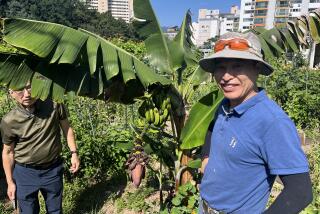Eating up a tropical landscape
- Share via
NOTHING says “tropical” more than the banana tree. Swaying above a pool, pond or patio, bobbing along an east-facing wall of a Colonial-style home, bananas can make semi-desert look like pseudo-jungle. Their hang-ten leaves surf waves of wind and call out for a tiki hut, their rewards not merely edible but ornamental too.
Fruiting and non-fruiting varieties present a banana-rama of appearances: green-leafed, red-leafed, variegated, giant, dwarf. The tree -- an herbaceous shrub, actually -- is almost entirely leaf. Tightly interwoven sheaths, one wrapped upon another much like celery, create what only appears to be a trunk.
So why all the talk of such tropical splendor in August, when every respectable gardener is bunkered in the shade with a ration of lemonade? Strangely enough, banana trees go into the ground now. This is their time.
Nick Tan designs edible and drought-tolerant gardens throughout Southern California and likes to plant bananas along property lines as a vertical screen. The shrubs are a good alternative to ligustrum or bamboo and are quicker-growing, he says, providing a sheltered, private vacation vibe.
Much like a magician pulling a bouquet from his sleeve, the banana reveals one gargantuan cluster of flower and fruit before taking a final bow. The inflorescence emerges from the center of the leaves, initially dressed as an elongated and elegant purple bud. As it blooms, cream-white flowers swirl around the stalk in double rows like Ziegfeld dancers. The fruit begins its routine shortly thereafter. After the edibles have ripened, the stalk dies, allowing newly sprouted foliage to carry on the show.
Ask Dennis Getchius how his passion for homegrown bananas began, and he’ll respond, “winged beans.” The Reseda resident was hunting through a seed catalog under “B” when he came across an offering for fingerling bananas. He bought a few rhizomes (root sections that generate adult plants).
“That first year I grew them in big 20-gallon pots, and they were very happy, looked great, but that was it,” says Getchius, an amateur rare fruit grower. “No fruit, not a thing.”
One might suspect Getchius’ problem stemmed from his locale, an arid area not known for its tropical breezes. But as he discovered, give bananas rich and well-draining soil as well as a site protected from scorching afternoon sun and seasonal Santa Ana winds, and they will perform nicely practically anywhere in Southern California.
Fariba Namiri’s shrub does well in her Santa Monica garden, where it adds a bit of tropical whimsy to a Mediterranean-style house. The plant -- deep green tinged with a beautiful maroon, and well-scaled for its space -- greets visitors by the front door without blocking windows.
Tan’s team at Urban Organics recently installed a small orchard in Eagle Rock. He toyed with the idea of using overhead rotary sprayers, but because the backyard was narrow he went with micro-misters to provide humidity, then each banana shrub got its own complement of soaker emitters.
Established bananas are pest- and disease-resistant and surprisingly drought-tolerant, if you’re willing to forgo fruit. But if you want a healthy harvest, your best friend very well may be a gray-water irrigation system, a serious soaker hose or a leaky spigot.
There are other rules of thumb, starting with temperature. “Usually bananas don’t like it below 50 or above 100,” Getchius says. “They’ll stop growing.”
Mulch is another secret to success.
“Wood chips, about 4 inches thick or so, seem to support such a healthy soil underneath them, that the bananas can more or less fend for themselves,” he says.
Turns out that the best mulch for a banana is last year’s banana. After the plant has been harvested and new stalks spring forth, the old foliage can be cut to the ground, chopped into pieces and spread out. This is also the time when you would stick a shovel straight down around one of the new shoots, dig it up and pass it on to a friend.
Bananas are known to have a sweet tooth for fertilizer, but exactly when to apply it can be confusing, especially considering recent weather patterns. The recommendation is to apply an all-purpose organic fertilizer that allows the plant to take up the nutrients it needs when it seems to need them, and not to force feed.
Many garden centers carry bananas, and if you’ve never grown them before, you may want to start with a nursery that can provide personal attention and expert advice. For the more rare varieties, try searching online.
‘Cavendish’ is the variety of banana whose stickers get peeled and slapped onto foreheads. Yellow, midsized, consistently sweet -- that’s the fruit everyone knows.
“I grow ‘Cavendish’ on the parkway because I can get those at the store,” Getchius says. “I say, if people take them, so what?”
The fruit also comes in peels of red, orange, purple, pink or green. One tastes like apples, while other varieties are likened to vanilla ice cream -- not a bad choice for a hot summer day.
Tony Kienitz is the author of “The Year I Ate My Yard.” He can be reached at home@latimes.com.






